Struggling with lighting that feels flat or doesn't highlight key features? Choosing the wrong downlight can mean wasted money and a poorly lit space. Let me show you the simple difference.
The main difference is flexibility. Fixed COB downlights provide uniform, general lighting from a single, static position. Adjustable COB downlights, on the other hand, can be tilted or rotated to aim the light beam, making them perfect for accent lighting or highlighting specific objects.
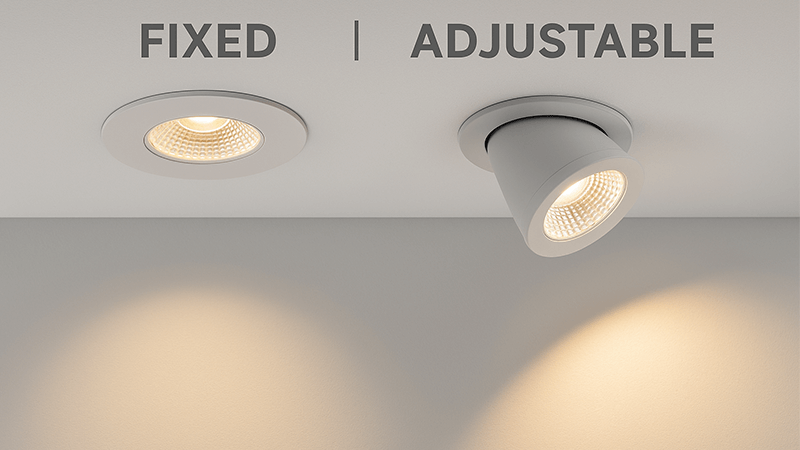
Choosing between fixed and adjustable downlights seems simple, but it's a decision that fundamentally shapes the feel and function of a room. As a manufacturer, I've seen countless projects succeed or fail based on this choice. It is not just about the fixture itself; it is about what you want the light to do. Getting this right from the start saves time, money, and ensures your client is happy with the final result. Let's dig deeper into the specifics so you can make the best choice for your next project.
What is the difference between adjustable and fixed downlights?
You have a perfect lighting plan, but the final installation just looks "off". The light is either too bland or focused incorrectly. This often happens from a simple misunderstanding of fixture types.
The key difference is control. Fixed downlights provide broad, general illumination, perfect for overall ambient lighting1 in a room. Adjustable downlights have a pivoting mechanism, letting you direct the light beam precisely. This is ideal for accenting artwork, architectural details, or creating task lighting2.
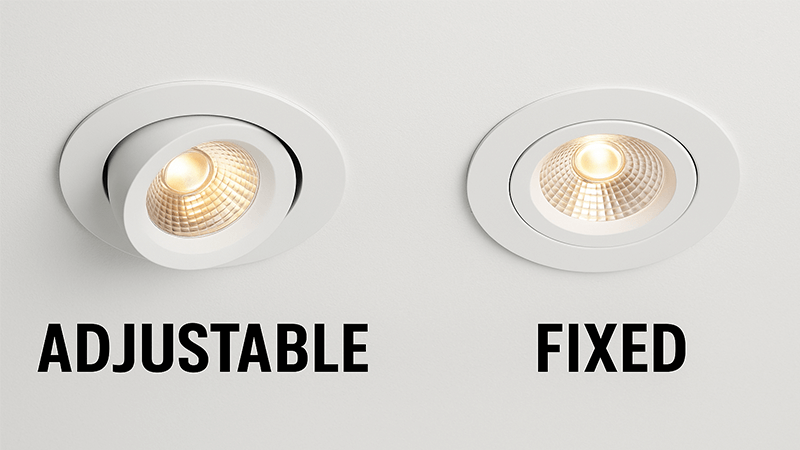
I often talk with purchasing managers like Shaz in the UAE who handle large commercial projects3. They know that this choice is critical. A fixed downlight is a workhorse, but an adjustable one is a specialist tool. The decision depends entirely on the lighting layer you are trying to create. Are you lighting up a whole corridor, or are you drawing attention to a sculpture in a hotel lobby? One requires a broad wash of light, the other a focused spotlight.
Application Defines the Choice
The best way to decide is to think in terms of lighting layers4. Every good lighting design5 uses a combination of ambient, task, and accent lighting.
- Ambient Lighting: This is the base layer of light that fills the room and allows you to move around safely. It creates a general sense of brightness. Fixed downlights are the champions of ambient lighting because they provide a wide, even distribution of light.
- Accent Lighting: This layer adds drama and visual interest. It's used to highlight specific features like artwork, plants, or textured walls. This is where adjustable downlights shine. You can aim them precisely to make these features pop.
- Task Lighting: This is focused light for specific activities like reading, cooking, or working at a desk. While other fixtures are often used, adjustable downlights can be an excellent solution for task lighting over a countertop or a reading nook.
A Practical Comparison
Let me break it down into a simple table. I find this helps many of my clients see the differences clearly.
| Feature | Fixed Downlight | Adjustable Downlight |
|---|---|---|
| Primary Use | General, ambient lighting | Accent, task, and feature lighting |
| Light Direction | Static, downward beam | Can be tilted/rotated to aim the beam |
| Best For | Corridors, open offices, general living areas | Galleries, retail displays, highlighting décor |
| Flexibility | Low | High |
| Installation | Very straightforward | Slightly more complex to aim and set |
| Visual Effect | Creates a uniform, even wash of light | Creates focused pools of light, adds contrast |
What is a fixed LED downlight?
You need reliable, even lighting for a large area without any fuss. But you are worried about creating a boring, flat environment. How do you get uniform light that still looks good?
A fixed LED downlight is a luminaire designed to cast light in a single, unchangeable downward direction. Its main purpose is to provide consistent, general illumination over a wide area. Think of it as the foundation of your lighting scheme, creating the overall brightness in a room.
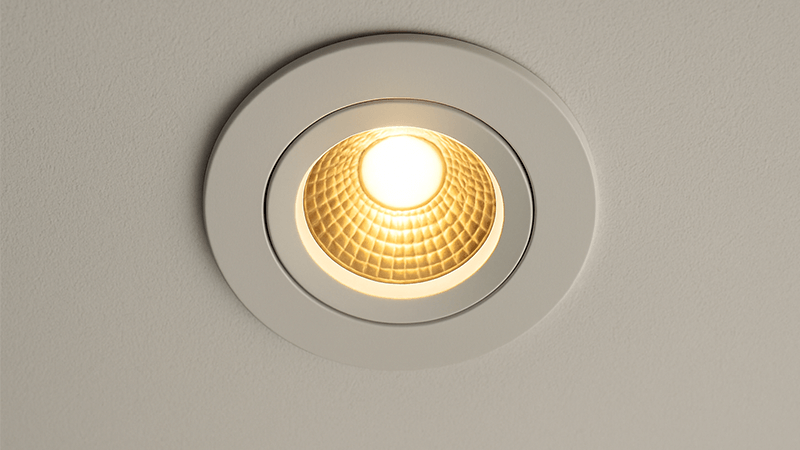
When I started in my first factory job, we made thousands of these. They are the backbone of commercial and residential lighting. A fixed downlight is defined by its simplicity and efficiency. It has no moving parts to direct the light, so the fixture itself is often more compact and cost-effective. The "fixed" nature means the beam angle6 you choose during specification is what you get. You cannot change it after installation7. That is why getting the beam angle and spacing right during the design phase8 is so important.
The Role of Simplicity in Design
The power of a fixed downlight is in its "set it and forget it" nature. For spaces like hallways, open-plan offices, or back-of-house areas, you don't need to highlight specific objects. You just need good, clear visibility. Fixed downlights deliver this perfectly.
- Reliability: With no moving parts like gimbals or swivels, there are fewer components that can fail. This makes them incredibly reliable for long-term installations where maintenance is a concern.
- Cost-Effectiveness: The simpler construction of fixed downlights generally makes them less expensive than their adjustable counterparts. For large projects where budget is a key driver, this can lead to significant savings.
Beam Angle is Everything
Since you cannot adjust the light's direction after it is installed, the beam angle becomes the most critical specification for a fixed downlight. I always tell my clients to think about the ceiling height and the desired effect.
| Beam Angle | Typical Use | Effect |
|---|---|---|
| Wide (>60°) | Low ceilings, general ambient light | Creates a soft, wide wash of light with minimal shadows |
| Medium (35-60°) | Standard ceiling heights, overlapping light pools | A good balance for general lighting, can create scalloping |
| Narrow (<35°) | High ceilings, creating pools of light on floors | Creates more dramatic, focused light, good for circulation |
When we supply fixed downlights for a large office project, for example, the purchasing manager and I will carefully review the floor plans. We will select a wide beam angle for the main open areas to ensure even coverage. Then we might use a medium beam for corridors to guide people visually. It's all about using this simple tool in a smart way.
Which is brighter, LED or COB?
You need the most light possible, but you are confused by the terms. Is "LED" different from "COB"? Which one will give your project the brightness and quality you demand?
This question has a simple mistake. COB, or "Chip on Board," is a type of LED. So, the real question isn't which is brighter, but what are the differences between COB LEDs and other LED types, like SMD (Surface Mounted Device).
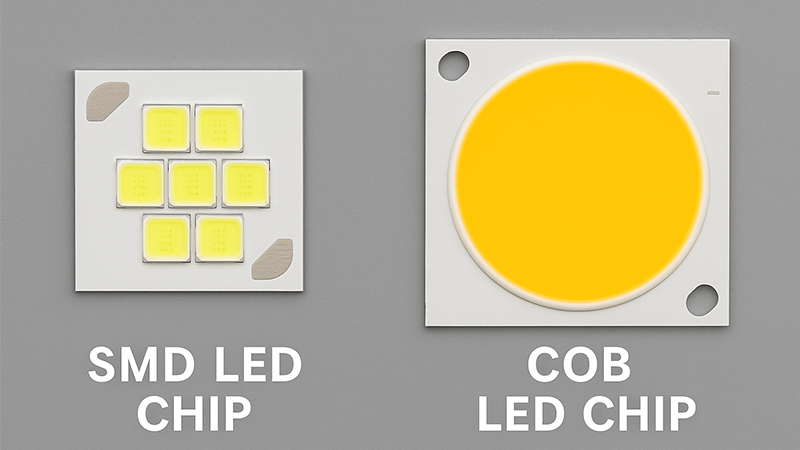
Thinking about "brighter" is a good start, but as an engineer and manufacturer, I encourage my clients to think about light quality and density. A COB LED packs many small LED chips into one large module. An SMD LED9 uses individual, larger chips that are spaced out. This single difference in structure changes everything about how the light looks and performs, which directly impacts your project's outcome.
Understanding Light Source Density
The key advantage of COB technology10 is its incredible light density. Because all the tiny LED chips are mounted directly onto a single substrate, they function as one powerful, uniform light source.
- COB (Chip on Board): Imagine a dense cluster of tiny stars packed together, creating one giant, single point of light. This produces a very intense, focused beam that looks similar to a traditional halogen lamp. It's perfect for spotlights and downlights where you want a punch of light with sharp, clear shadows. There are no multiple-shadow effects.
- SMD (Surface Mounted Device): Now imagine those same stars spread out over a larger area. Each star is a visible point of light. This is how SMD LED9s work. They are great for creating diffuse, wide-angle light, like in LED bulbs, strips, or panels. The light is softer and less intense from a single point.
Which One is Right for You?
So, back to the brightness question. A single COB module can produce a huge amount of lumens from a very small area, making it seem "brighter" in a directional fixture. That's why nearly all high-quality adjustable and fixed downlights today use COB technology. It allows us to create powerful, compact fixtures with excellent light control.
Here is a table to help you decide which technology fits your application:
| Feature | COB (Chip on Board) LED | SMD (Surface Mounted Device) LED |
|---|---|---|
| Light Appearance | Single, intense point of light; no multiple shadows | Multiple points of light; can create softer, diffuse light |
| Light Density | Very high | Lower |
| Best For | Downlights, spotlights, track lights (focused light) | Panels, strip lights, bulbs (area lighting) |
| Heat Management | Requires a good heat sink due to high power density | Heat is more spread out, easier to manage in some designs |
| Efficiency (lumens/watt) | Generally very high | Also very high, but COB often leads in high-power apps |
When a client like Shaz asks me for a high-performance downlight, I always recommend a COB solution. The quality of the beam, the lack of multiple shadows, and the sheer power we can get from a small fixture are exactly what high-end commercial and hospitality projects require.
What is a tunable downlight?
Your project needs lighting that can adapt to different times of day or activities. Fixed color temperature feels too restrictive. How can you get one light fixture to do it all?
A tunable downlight11 lets you change the color temperature of the white light it produces. You can adjust it from a warm, cozy light (like a sunset) to a cool, energizing light (like midday sun), all from the same fixture.
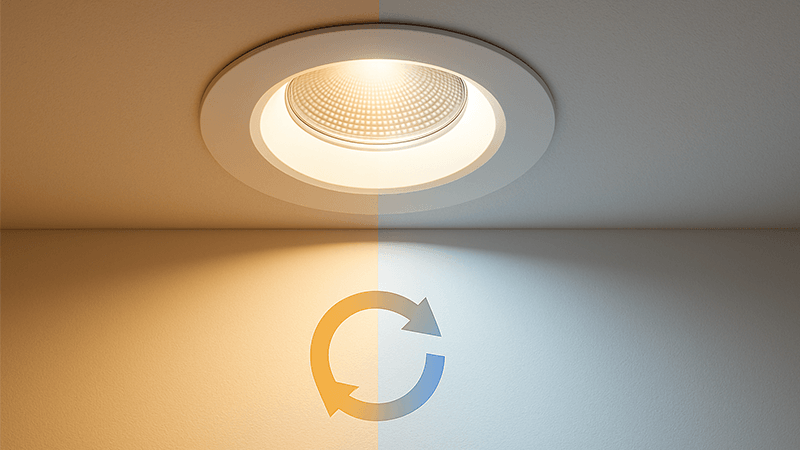
This technology is a game-changer. I have been in the lighting industry for a long time, and the shift towards tunable white is one of the biggest innovations I have seen. It moves lighting from a static element to a dynamic tool that can support human well-being and adapt to the function of a space. It is not just about brightness (dimming) anymore; it is about changing the entire mood and feel of the environment.
The Science of Tunable White
Tunable white technology, also known as Kelvin-tuning, works by using two sets of LEDs within one fixture: one set that produces warm white light (e.g., 2700K) and one set that produces cool white light (e.g., 6500K). By mixing the output of these two channels, you can create any color temperature in between.
This aligns with the concept of Human-Centric Lighting12 (HCL). HCL aims to create lighting that mimics the natural daily cycle of sunlight.
- Morning/Afternoon: Cool, bright light (4000K-6000K) can increase alertness, concentration, and productivity. This is ideal for offices, schools, and task-heavy environments during the day.
- Evening: Warm, dim light (2700K-3000K) promotes relaxation and helps our bodies prepare for sleep. This is perfect for homes, restaurants, and hotel rooms in the evening.
Practical Applications and Benefits
The ability to control color temperature opens up huge possibilities for almost any space. I worked on a project for a multi-purpose conference center that needed to switch from a high-energy corporate training session to a relaxed evening awards dinner in the same room. Tunable downlights were the perfect solution.
Here is how tunable white can be used in different settings:
| Application | Morning/Daytime Setting (Cool White) | Evening/Relaxed Setting (Warm White) |
|---|---|---|
| Office | 5000K for focus and productivity during work hours. | Dimmed 3000K for after-hours events or cleaning. |
| Hospitality | 4000K in a hotel lobby for a bright, welcoming check-in. | 2700K in the same lobby for a cozy, lounge-like feel. |
| Retail | 4000K-5000K to make products look crisp and vibrant. | Can be adjusted to best complement specific merchandise. |
| Healthcare | 6500K in examination rooms for accurate visual diagnosis. | 3000K in patient rooms to promote rest and recovery. |
For a purchasing manager, offering tunable lighting adds incredible value. It provides clients with a flexible, future-proof system that can be adapted to their changing needs, making it a powerful selling point for any high-end project.
Conclusion
Choosing between fixed and adjustable COB downlights13 depends on your goal. Use fixed for general light and adjustable for highlighting details. Understanding this makes your lighting design truly effective.
Explore the role of ambient lighting in creating a comfortable and functional environment. ↩
Understand the significance of task lighting for specific activities and productivity. ↩
Explore common challenges in commercial lighting and how to overcome them effectively. ↩
Learn about lighting layers to create a balanced and effective lighting scheme. ↩
Understand the principles of lighting design to create functional and aesthetically pleasing spaces. ↩
Discover how beam angle influences the effectiveness of fixed downlights in various settings. ↩
Explore important installation factors to ensure optimal performance of downlights. ↩
Learn key considerations during the design phase to ensure successful lighting outcomes. ↩
Understand the differences between SMD and COB LEDs to make informed lighting choices. ↩
Explore the advantages of COB technology for high-quality, efficient lighting solutions. ↩
Discover how tunable downlights can adapt to different environments and enhance user experience. ↩
Learn about Human-Centric Lighting and its impact on well-being and productivity. ↩
Learn how adjustable COB downlights can enhance accent lighting and design versatility. ↩

